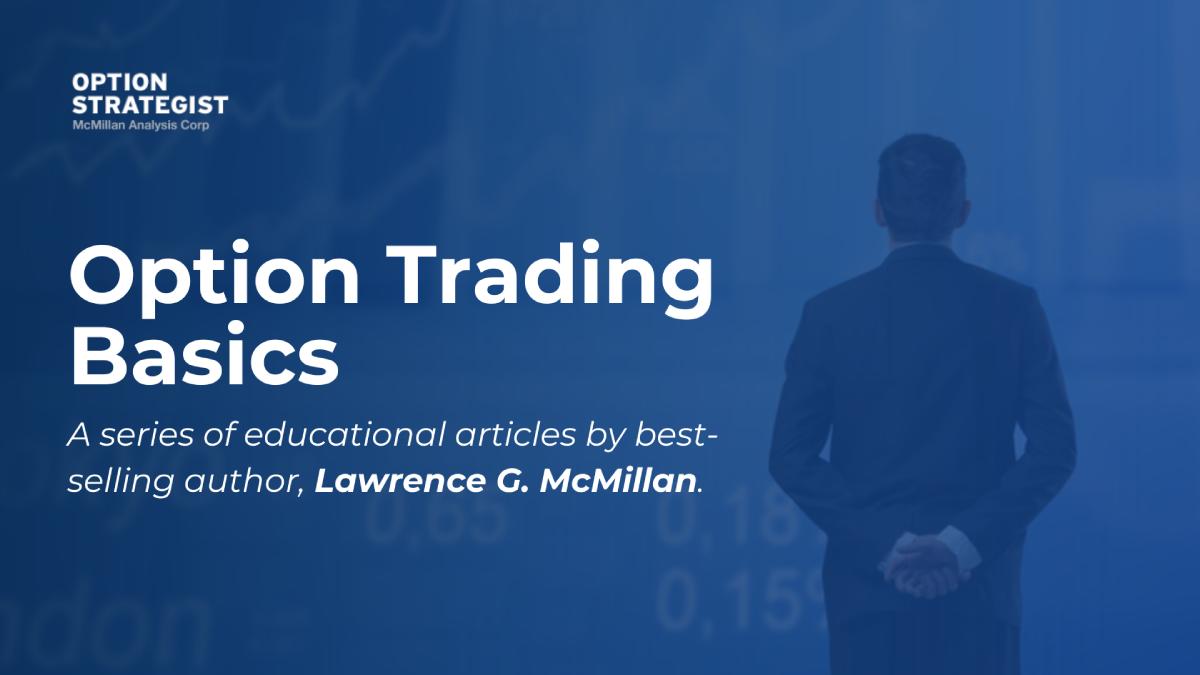
By Lawrence G. McMillan
This article was originally published in The Option Strategist Newsletter Volume 4, No. 4 on February 23, 1995.
If it seems that we preoccupied with volatility, it's because we are. It is the only variable factor in determining the fair value of an option; the others are known with certainty at any point in time — strike price, time remaining until expiration, stock price, dividends, and short-term interest rates. However, it has practical and real application as well. If you buy options when volatility is low, then you stand to gain doubly if volatility increases. Or, even if you're wrong on the direction of the underlying market, your loss will be reduced if volatility increases. Some examples may help to clarify these points.
Example: Suppose you're bearish on the market at a
point where OEX is trading at 450. Furthermore,
implied volatility is low – about 10%. On February
22nd, the following prices might exist:
Price Implied Vty
OEX 450
Mar 445 put 2½ 10%
Apr 445 put 4 10%
At this point, several things could happen. One would be that implied volatilities rose without OEX changing much in price. That is a rather unlikely scenario, although slight rises in implied volatility can occur without much change in the price of the underlying. For purposes of our example, though, let's assume for a moment that, by the next trading day, OEX volatility rises to 17% (where it's been a couple of times in the past year). The March 445 put would then be trading at 5½ and the April 445 put at 8½! That clearly shows the power of volatility on the price of an option.
A more likely scenario, however, would be for some time to pass before volatility could rise that much. In the case of an index, the market would probably have to experience a rather sharp selloff in order to get volatilities to rise that quickly. Then, even if there were a rally after that selloff, implied volatilities would remain at inflated levels. The following table summarizes where these two puts would be trading if OEX implied volatility rose to 17% two weeks after the puts were purchased. Note that three different OEX prices are shown, so that you can see how the puts would be affected by varying degrees of market movement.
OEX Price: 440 445 450 Mar 445 put 8¼ 5½ 3 Apr 445 put 12 9½ 7½
There are several observations that can be made from the above table. The first is in the right-hand column. OEX is unchanged from when the puts were purchase, although two weeks have passed. The increase in implied volatility actually produced a profit in both puts even though two weeks have passed. In fact, the April puts show a healthy profit since they would have significantly more time remain-ing than the March puts, after two weeks have passed.
The "double profit" that we referred to earlier is evident if you look at either of the other two columns in the above table. In that case, not only has the market fallen (a favorable event for put holders), but the implied volatility has increased as well. Thus, profits are substantial. Consequently, buying options when volatility is low can produce profits in either of two ways.
"Crash" Volatility
Before leaving this topic, I'd like to relate a true story from the 1987 crash. On the Wednesday before the crash (10/14/87), OEX was trading at 295. A customer paid 1-1/8 for the December 320 calls. These calls were trading with an implied volatility of about 15%, which was actually quite low for that era.
On the following Monday (10/19/87), the market crashed, and OEX was trading at 230. The customer figured he had lost his entire investment and, considering the large losses that others had taken, he was actually glad to have only lost a point and an eighth. He didn't even bothering getting a quote on these options until Tuesday, the day after the crash, because he figured there wouldn't be any bid for them if he wanted to sell them.
What he didn't realize was that implied volatility had skyrocketed to nearly 50% for OEX options in the wake of the crash. The December 320 calls — now 90 points out of the money with less than two months until expiration — were trading at 1! Thus he had only lost an eighth. The power of implied volatility is great; it can even bail out losing trades sometimes.
This article was originally published in The Option Strategist Newsletter Volume 4, No. 4 on February 23, 1995.
© 2023 The Option Strategist | McMillan Analysis Corporation

